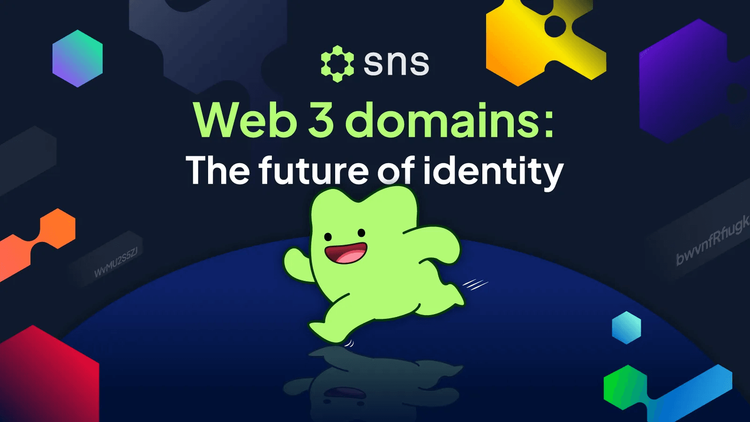Why Web3 Domains Are the Future of Identity

Discover how .sol Web3 domains go beyond payments to reshape online identity.
The internet is evolving once again. After decades of Web2 being dominated by centralized platforms, a new model of digital ownership is emerging: Web3 identity. At the heart of this shift are Web3 domains – simple, human-readable names that represent you across the decentralized web.
Traditional domains helped build the internet as we know it, but they were never designed for decentralized systems, digital assets or global peer-to-peer transactions. Web3 domains fix these gaps and unlock a new way of proving identity online.
The Problem with Traditional Domains
The domain name system (DNS) has been the backbone of the internet for decades. It works reliably for websites and email, but it was designed for a very different era. As the internet shifts toward digital assets and decentralized applications, some of DNS’s limitations are becoming clear.
Centralized Control
DNS is governed by ICANN and managed through registries and registrars. While this ensures standardization, it also concentrates control. If a registrar dispute arises or a registry changes its policies, a domain can be suspended or revoked. For businesses and individuals, this reliance on intermediaries means your online presence is never entirely in your hands.
Renewal Costs and Dependency
Traditional domains are leased rather than owned. They require annual renewal fees, and if you forget to renew or lose access to your registrar account, you risk losing the name. The system ensures availability for many users, but it highlights how fragile ownership can be under this model.
Not Built for Identity
Traditional domains work well for pointing to websites or email servers, but they were never designed to serve as digital identities. They cannot connect directly to wallets, hold assets, or represent you across decentralized applications. As people increasingly interact with crypto, NFTs and on-chain credentials, this limitation becomes more apparent.
What is Web3 Identity?
Web3 identity is a way to represent yourself across the decentralized internet using blockchain technology. Instead of usernames and passwords stored on company servers, identity is tied to cryptographic keys that only you control.
A Web3 domain becomes the anchor for this identity. It replaces long wallet addresses, serves as your login for dApps and links to decentralized content. Because it lives on a blockchain, it cannot be seized, suspended or redirected without your consent.
This gives users a portable identity that moves with them across platforms, wallets and applications – a stark contrast to the siloed accounts of Web2.
How Web3 Identity Solves It
Web3 identity addresses the limitations of traditional domains by using blockchain technology to create systems that are decentralized, portable and multi-functional. Instead of relying on registrars and renewals, your wallet keys secure ownership, and your domain can function as more than just an online address.
Decentralization Removes Gatekeepers
Web3 domains are recorded directly on blockchains. There are no registrars or central bodies like ICANN in control, which means your domain cannot be revoked or altered by an intermediary. The result is a system where your identity is tied only to your wallet and cryptographic keys, not to a third party.
Permanent and Portable
On Solana, .sol names are designed as one-time purchases rather than ongoing subscriptions. Once a domain is registered, it is linked to your wallet and can be used across the entire Solana ecosystem. This portability makes your identity more durable and transferable between apps and services without dependency on a single provider.
Multipurpose by Design
Unlike traditional domains that focus on websites and email, Web3 domains are built to serve as identity layers. A .sol name can be used to simplify crypto transactions, replace wallet addresses, log in to decentralized applications, or link to decentralized storage like IPFS and Arweave. Over time, they can also anchor on-chain credentials and reputation, giving them a role that extends far beyond hosting content.
Ready to Own Your Web3 Identity?
The shift from Web2 to Web3 is not just about technology – it is about control and ownership. Traditional domains tie you to registrars, renewals and centralized control. Web3 domains put your identity in your hands, backed by the security and permanence of blockchains.
Securing a name like yourname.sol is one of the simplest ways to step into Web3. It simplifies transactions, gives you a portable identity and positions you for the future of digital ownership.
Head over to https://sns.id to claim your Web3 identity today.
FAQ
Are Web3 domains the same as traditional domains?
No. Traditional domains are managed by registrars. Web3 domains are recorded on blockchains and are controlled directly by the user.
Can I use a Web3 domain on a regular website?
Yes. You can link Web3 domains to decentralized storage like IPFS or Arweave and in some cases connect them to traditional hosting as well - for now these require gateways.
How do Web3 domains facilitate crypto transactions?
Instead of sharing a long address, you share a simple name like alex.sol. The blockchain resolves it automatically to the right wallet.
Are Web3 domains a good investment?
Their primary value lies in usability and identity. Some domains may increase in market value, but the true benefit is control, functionality and ease of use in Web3. Under all circumstances please do your own research and this is not financial advice.
References
- Solana Foundation – Solana Docs: Introduction
- Consensys – What is Web3?
- Ledger Academy – What is Web3?
- Solana Name Service Docs – Manage Your Domains
- QuickNode – How to Create a .sol Domain Using Solana Naming Service
- CoinDesk – What Are Blockchain Domains?
- Sovrin Foundation – Self-Sovereign Identity: A Guide